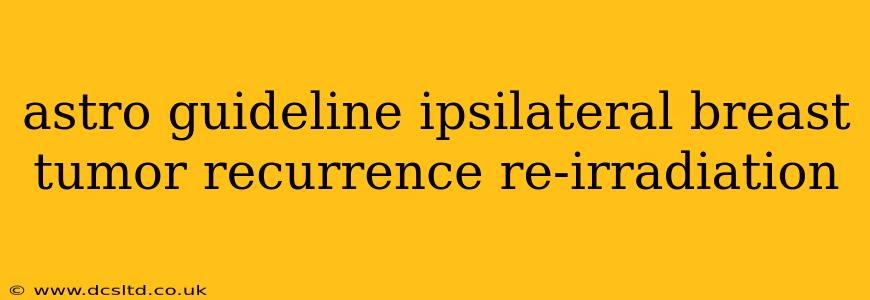Breast cancer recurrence, specifically ipsilateral breast tumor recurrence (IBTR), presents a significant challenge in oncology. Re-irradiation is sometimes considered a treatment option, but the decision is complex and requires careful consideration of various factors. This article will delve into the ASTRO (American Society for Radiation Oncology) guidelines regarding re-irradiation for IBTR, exploring the criteria for patient selection, treatment planning, and potential outcomes. We'll also address common questions surrounding this complex issue.
What is Ipsilateral Breast Tumor Recurrence (IBTR)?
IBTR refers to the recurrence of breast cancer in the same breast where the initial cancer was diagnosed and treated. This recurrence can manifest in various ways, including local recurrence at the initial tumor site, in-breast recurrence at a new site within the same breast, or chest wall recurrence. The presence of IBTR significantly impacts prognosis and necessitates a multidisciplinary approach to treatment planning.
When is Re-irradiation Considered for IBTR?
Re-irradiation for IBTR is not a universally applied treatment. The ASTRO guidelines emphasize a careful selection process based on several key factors:
- Histological confirmation of recurrence: A definitive diagnosis of recurrent breast cancer is crucial before considering re-irradiation. Biopsy is necessary to confirm the nature of the recurrence and its suitability for radiation therapy.
- Extent of recurrence: The size and location of the recurrence influence the decision. Smaller, localized recurrences are generally more amenable to re-irradiation than extensive or diffuse recurrences.
- Patient's overall health and performance status: Re-irradiation can have significant side effects. Patients with compromised health or poor performance status may not tolerate the treatment well.
- Prior radiation dose: The total dose of radiation previously delivered to the breast significantly influences the decision. Higher initial doses limit the tolerance for further radiation.
- Time since initial radiation: The time elapsed since the initial radiation therapy is also a factor. Longer intervals may make re-irradiation more feasible.
What are the Techniques and Considerations for Re-irradiation in IBTR?
Re-irradiation techniques aim to deliver a therapeutic radiation dose to the recurrent tumor while minimizing damage to the surrounding healthy tissues, already exposed to prior radiation. Advanced techniques like intensity-modulated radiation therapy (IMRT) and volumetric modulated arc therapy (VMAT) are often used to achieve this goal. Careful dose planning is crucial to balance efficacy and toxicity.
What is the role of surgery in IBTR?
Surgery may be considered alongside or prior to re-irradiation, depending on the characteristics of the recurrence. Surgical resection of the recurrent tumor followed by re-irradiation is sometimes employed, particularly for smaller, localized recurrences.
What are the potential side effects of re-irradiation for IBTR?
Re-irradiation carries a higher risk of side effects compared to initial radiation therapy. These side effects can include:
- Skin reactions: Increased risk of radiation dermatitis, including erythema, desquamation, and pain.
- Breast fibrosis: Increased stiffness and hardening of the breast tissue.
- Lymphedema: Swelling in the arm or hand on the affected side.
- Pneumonitis: Inflammation of the lung tissue.
- Cardiac toxicity: Damage to the heart, especially with re-irradiation involving the chest wall.
What is the prognosis after re-irradiation for IBTR?
The prognosis for patients undergoing re-irradiation for IBTR is variable and depends on various factors, including the size and extent of the recurrence, the patient's overall health, and the response to treatment. While re-irradiation can improve local control rates, it doesn't guarantee a cure. Close follow-up is crucial to monitor disease progression and manage potential side effects.
How effective is re-irradiation for IBTR?
The effectiveness of re-irradiation for IBTR varies depending on the specific case and factors discussed above. While it can improve local control and potentially prolong survival, it's important to manage expectations realistically. The ASTRO guidelines emphasize that re-irradiation should be considered within a comprehensive treatment plan involving a multidisciplinary team of oncologists, surgeons, and radiation oncologists.
What are the alternative treatments for IBTR?
Alternatives to re-irradiation may include systemic therapies such as chemotherapy, targeted therapy, or hormone therapy, depending on the characteristics of the recurrent tumor and the patient’s individual circumstances. These treatments often are used in combination with or instead of re-irradiation. The choice of treatment will be personalized based on several factors.
This information is for educational purposes only and should not be considered medical advice. Always consult with a qualified healthcare professional for diagnosis and treatment of any medical condition. The guidelines mentioned are subject to change as new research emerges in the field of oncology.
